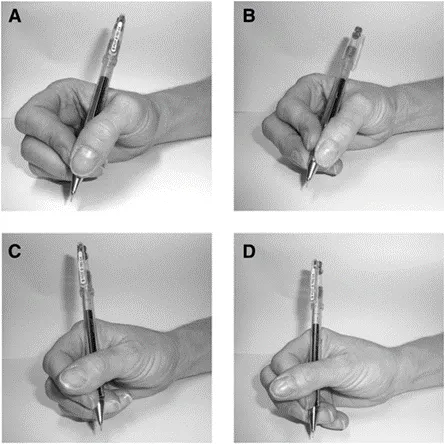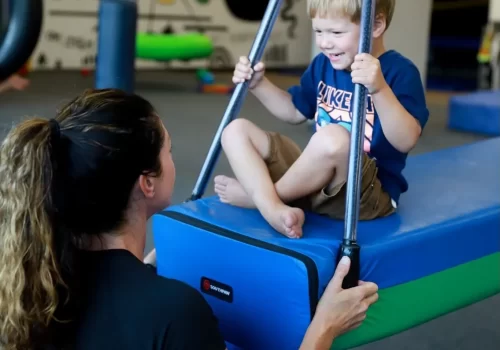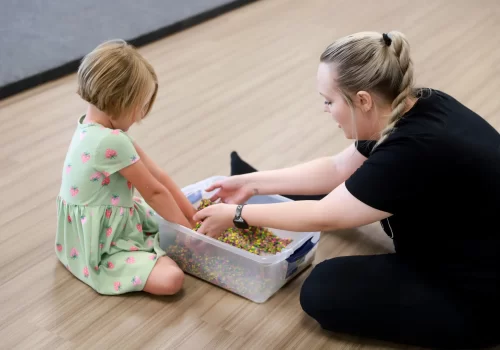The start of the new school year is under way, which comes with new opportunities as well as new challenges. Of those challenges, atypical pencil grasp patterns and how they affect handwriting skills are a common concern for many teachers and parents. The concern stems from how ongoing handwriting difficulties have the potential to influence a child’s development and negatively affect their academic performance. In turn, this may be harmful to self-esteem and the child’s self-perception of their abilities (Schwellnus et al., 2013). However, can it be said that all atypical pencil grasp patterns will lead to handwriting problems?
First, let’s talk about what typical or mature pencil grasp patterns look like it. There are four mature grasp patterns that have been labeled as best for functional handwriting (Dennis & Swinth, 2001; Schwellnus et al., 2012; Schwellnus et al., 2013). This includes dynamic tripod, dynamic quadruped, lateral tripod, and lateral quadruped. Historically, the dynamic tripod grasp has been promoted as the “gold standard” grasp pattern, but research has shown that the other three are equally as efficient and effective.

- Dynamic Tripod (B) Dynamic Quadruped (C) Lateral Tripod (D) Lateral Quadruped (Schwellnus et al., 2013)
As occupational therapists, teachers and parents often call on us for help when a child’s grasp pattern does not resemble one of those four mature grasps. However, it is also our job as professionals to question if a presented developmental concern is truly causing dysfunction and whether it requires evaluation and treatment. Within the current research, there is a significant lack of studies that adequately compare handwriting performance of the accepted four mature grasp patterns to immature or atypical grasp patterns. Therefore, it would be incorrect to automatically assume that a child with an atypical grasp pattern will develop handwriting difficulties.
So, when should you intervene to try and “fix” a child’s pencil grasp?
Here are some things to consider before changing a child’s pencil grasp:
- Is it holding them back in class?
- Is it preventing the child from keeping up with the written material that is expected of them at their grade level?
- Are they rushing or writing slower in comparison to their classmates?
- Is it affecting the child’s motivation?
- Example: Child is writing brief answers on school assignments because it is quicker.
- Is it legible?
- Can you read and understand what they have written?
- Is it painful?
- Is the grasp pattern creating awkward finger or hand positions that results in discomfort or pain when the child is writing or drawing?
- Does it cause fatigue?
- Is the child using their whole arm or wrist while writing or drawing?
- What does the child think or how do they feel about their pencil grasp?
- What is their reason for holding a pencil the way they do? Does it feel more stable to them?
- Is their current pencil grasp causing them stress?
So, with all of that said, will all atypical grasp patterns lead to handwriting difficulties?
Simple answer: No. It is only when dysfunction occurs that “fixing” a child’s pencil grasp is needed. Otherwise, it is perfectly safe to leave it be!
If you happen to have questions about your child’s pencil grip, reach out to us below!
References
Dennis, J. L. & Swinth, Y. (2001). Pencil grasp and children’s handwriting legibility during different-length writing tasks. American Journal of Occupational Therapy, 55(2), 175-183. https://doi.org/10.5014/ajot.55.2.175
Schwellnus, H., Carnahan, H., Kushki, A., Polatajko, H., Missiuna, C., & Chau, T. (2012). Effect of pencil grasp on the speed and legibility of handwriting in children. American Journal of Occupational Therapy, 66(6), 718-726. https://doi.org/10.5014/ajot.2012.004515
Schwellnus, H., Carnahan, H., Kushki, A., Polatajko, H., Missiuna, C., & Chau, T. (2013). Writing forces associated with four pencil grasp patterns in grade 4 children. American Journal of Occupational Therapy, 67(2), 218–227. https://doi.org/10.5014/ajot.2013.005538


